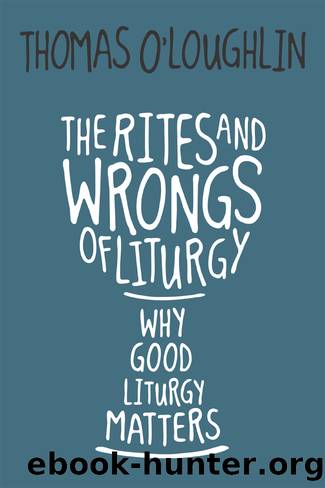The Rites and Wrongs of Liturgy by Thomas O'Loughlin

Author:Thomas O'Loughlin
Language: eng
Format: epub
Publisher: Liturgical Press
Published: 2018-04-19T00:00:00+00:00
Openness and Identity
Is there another approach? We tend to think of a gathering celebrating liturgy as an already existing community who then chose to do something: celebrate a particular liturgy. Perhaps our ideal should be to start at the other end and draw the actual gathering together such that they recognize themselves as a community in Christ because they are there engaging in worship. This is a challenge both as a piece of communication and as catechesis, but it accords with our deepest instincts as Christians that liturgy should not only express community but build the new community of disciples. This endeavor starts from the reality of what we are doing when we gather. Each person is a member of the people of God, as much as a member of the priestly people as anyone else, and the worship should be the common offering of all those present. This is a very different vision of the gathering from that of the liturgy being really that which the priest does, while the congregation are âin attendanceâ (the pre-Vatican II model), or that of liturgy being that of a special few, the people with specific tasks (the presider, the readers, the choir) or âthe worship team,â who âput onâ a liturgy for the othersâ benefit (a model that fits our consumerist society). If we are the people of God, and each one of us made a daughter or son by adoption, then every liturgy must be our liturgy and so that of each and every one present.
This is the great goal of âfull and active participationâ called for by Vatican II. So the task is to let us discover, perhaps through a question-and-answer session, in this actual situation:
how are we a communityâwhy have such a variety of individuals come to one place;
what is it that characterizes us as âusâ here;
what have each of us present to offer to the others today;
how should we express on this occasion whatever identity we have found;
how should that which is standard and inherited be adapted to the spontaneity by this moment;
what should be the tone and flavor of our worship on this occasion?
Download
This site does not store any files on its server. We only index and link to content provided by other sites. Please contact the content providers to delete copyright contents if any and email us, we'll remove relevant links or contents immediately.
| Catechisms | Devotionals |
| Hymns & Hymnals | Meditations |
| Monasticism & Asceticism | Pentecostal & Charismatic |
| Prayerbooks | Rites & Ceremonies |
| Sacraments |
Fangirl by Rainbow Rowell(8808)
How to Bang a Billionaire by Alexis Hall(7942)
Wonder by R. J. Palacio(7750)
The Space Between by Michelle L. Teichman(6589)
The Thirst by Nesbo Jo(6458)
Assassin’s Fate by Robin Hobb(5867)
Wiseguy by Nicholas Pileggi(5336)
The Night Circus by Erin Morgenstern(5044)
The Kite Runner by Khaled Hosseini(4963)
Paper Towns by Green John(4815)
Bittersweet (True North #1) by Sarina Bowen(4720)
Gerald's Game by Stephen King(4386)
Too Much and Not the Mood by Durga Chew-Bose(4105)
Pillow Thoughts by Courtney Peppernell(4039)
Goodbye Paradise(3464)
Twelve Days of Christmas by Debbie Macomber(3421)
Good by S. Walden(3361)
The Rosie Effect by Graeme Simsion(3223)
The Cellar by Natasha Preston(3081)
